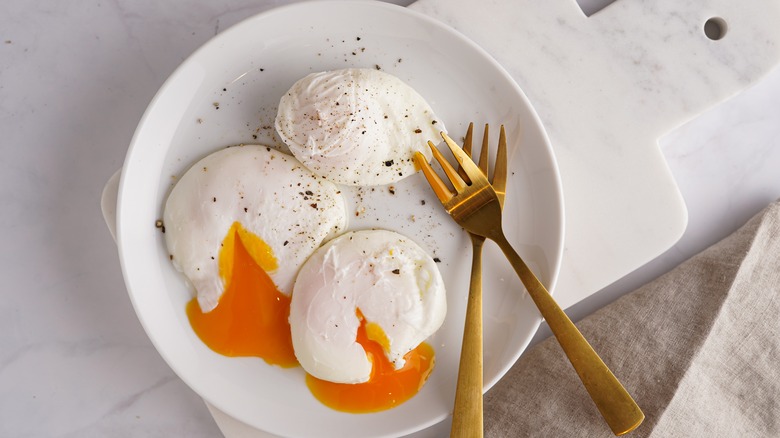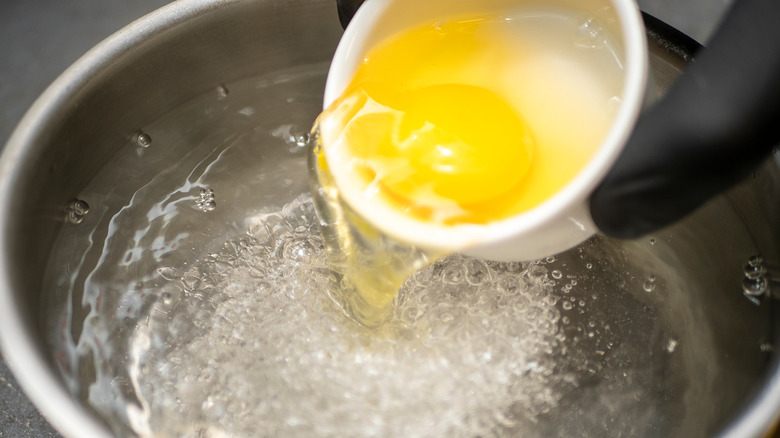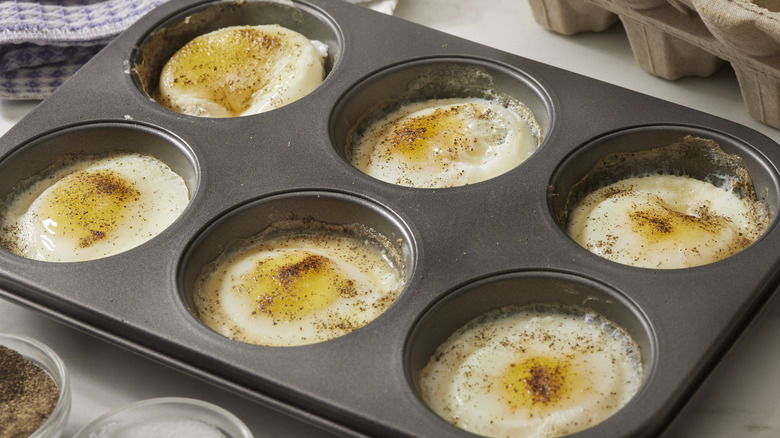Expert Tips For Poaching Eggs For A Crowd
Some elements of a classic brunch just can't be left out. Orange juice, sparkling wine, and coffee? Check. A simple but elegant table setting? Check. As for the food, nothing says brunch quite like poached eggs, whether you're crowning a plate of eggs Benedict or Florentine or fancying up some avocado toast. However, these delicate eggs are also notoriously tricky to pull off — especially when trying to cook for a group.
Food Republic spoke to Nelson Serrano-Bahri, Director of Innovation at the American Egg Board, to find out the easiest way to poach eggs for a crowd. He suggests cooking them ahead of time, then warming them up just before serving. Unless you're a line cook, whipping up poached eggs to order will have you shouting like you're on an episode of "The Bear" before those whites have even set.
There are tons of ways to make poached eggs, so use a method that you've been successful with in the past. According to Serrano-Bahri, some mistakes to avoid when making poached eggs include using too small a pot and bringing the poaching water to a boil instead of a simmer. Also, having a poorly organized work space is a common mistake people make with eggs Benedict, and other fancy multi-part brunch dishes. Things move quickly once those eggs get dropped in the water, so you don't want to be fumbling for an extra plate or slotted spoon once they're done.
How to poach eggs in advance
The most basic way to poach eggs is to bring a pot of water to a simmer, then crack an egg into a ramekin, small bowl, or measuring cup. Stir the water to create a vortex, and gently drop the egg right in the middle. If you move quickly, you can poach a couple at a time. Normally, you would cook them for two to three minutes for a set white and runny yolk, but since you're making them ahead of time, Nelson Serrano-Bahri suggests pulling them out a few seconds before then.
Once you remove the eggs, carefully pat them dry with paper towels and put them on a parchment-lined plate or small sheet tray in the refrigerator, if you plan to serve them soon. Otherwise, transfer them to an airtight container in the fridge, where they'll keep for up to two days.
When it's time to reheat the eggs, Serrano-Bahri says to bring a pot of water up to 135 degrees Fahrenheit. This is just below the quiver stage, where very small bubbles will form all over the bottom surface of the pan. Using a slotted spoon or spider strainer, dunk the eggs in for no more than 45 seconds to warm them through. Transfer them to a warm plate lined with a paper towel so they can quickly dry off before serving them in your favorite recipes.
More tricks for poaching eggs for a crowd
If you decide that poaching eggs the traditional way is too much fuss, you're not the only one. There are a number of gadgets on the market that can help you "cheat" at making perfect eggs. While eggs can only be called "poached" if they're cooked while submerged in water, these easier eggs still do a very good job of standing in.
Silicone egg poaching cups can be set directly in hot, shallow water, then you crack each egg into its own little holder to cook. These tools are easy to maneuver and you can make a bunch of eggs at once using a large pot. There are also special egg poaching pans that feature individual inserts for each egg. Both of these gadgets essentially steam the eggs, so the texture will be a bit firmer, but they'll certainly do the trick.
If an investment in a specialized tool doesn't feel worth it to you, the muffin tin hack that makes poaching eggs way easier may be the way to go. A bit of water goes into the bottom of each cup, the egg gets cracked on top, and they get cooked in the oven. Though the final eggs will have a hockey puck shape that's less than traditional, the flavor, texture, and ease of execution make this method worth a try.



